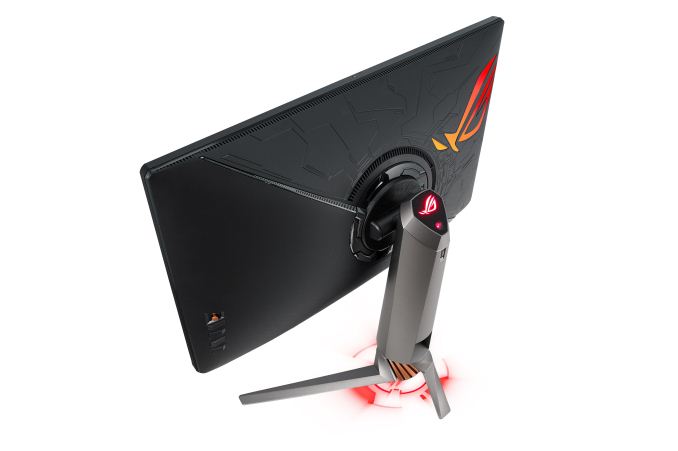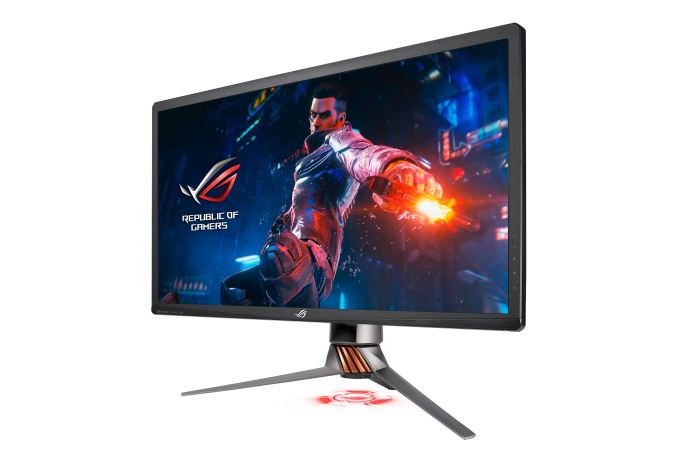The Asus ROG Swift PG27UQ G-SYNC HDR Monitor Review: Gaming With All The Bells and Whistles
by Nate Oh on October 2, 2018 10:00 AM EST- Posted in
- Monitors
- Displays
- Asus
- NVIDIA
- G-Sync
- PG27UQ
- ROG Swift PG27UQ
- G-Sync HDR
The (Asus) G-Sync HDR Experience: Premium Panel for Premium Price
In the end, gamers are given the ultimate guidance with the price point: $2000. The cost doesn't pull any punches, and while it may not be explicitly communicated to consumers, the price is all about the panel functionality, while everything else takes the backseat. Though we can only say this directly about the Asus PG27UQ, this is presumably the case for Acer's Predator X27, which shares the connectivity, large physical design, and active cooling setup.
Some of this is out of Asus's hands, and with the G-Sync HDR module's capabilities and limitations, something that they can only package up and support the best they can. Manufacturers on the display design side would be limited in expanding the basic range of use of G-Sync HDR. Some aspects are even out of NVIDIA's hands when it comes to HDR support in the OS, which goes back to Windows' historically poor management of anything non-SDR and non-sRGB; if the monitors were ready before the Windows 10 April 2018 Update, ease-of-use would've been a big issue.
As one of two current G-Sync HDR implementations, the Asus PG27UQ is also just one of three VESA DisplayHDR 1000 certified products, alongside the Acer counterpart and a Phillips 4K TV, and one of three UHDA Premium certified monitors, alongside two proviz monitors. So by certifications, it would be one of the best HDR PC monitors on the consumer market anyway, G-Sync or otherwise. It seems more likely than not that the 35-inch and 65-inch models are not imminently ready, although resolving firmware issues with FALD backlighting should be a shared investment between them. But for now, G-Sync HDR can only truly stretch its legs in a niche case: single-monitor non-silent PC gaming with HDR titles on NVIDIA G-Sync HDR supporting hardware powerful enough to target 4Kp144 target. The last bit is already niche on its own: the GeForce GTX 1080 Ti was the first card to really hit 60fps on no-compromises 4K, and both AMD and NVIDIA have stepped back from multi-GPU and multi-card solutions.
As an aside, we know now 144fps is perhaps even further out given that NVIDIA's next generation offering of the GeForce RTX 2080 Ti is more-or-less in the Titan V gaming performance bracket, which is to say it's only about 37% faster than the GTX 1080 Ti. The majority of this review was done prior to the RTX 2080 Ti and RTX 2080 launch, but doesn't fundamentally alter the core premise of 4Kp144 being out-of-reach.
And when you're paying more dollars than most people have horizontal pixels on their screen, especially when that price is especially baked in to that use case, that niche becomes extremely relevant. There's no price tiering right now in terms of non-4K G-Sync HDR or non-HDR 4Kp144 G-Sync, so pursuing either combination still leaves you at the $2000 price point. So let's find out if the prospect of playing PC games with the cutting-edge of 2018 visuals measure up.












91 Comments
View All Comments
Flunk - Tuesday, October 2, 2018 - link
I'd really like one of these, but I can't really justify $2000 because I know that in 6-months to a year competition will arrive that severely undercuts this price.imaheadcase - Tuesday, October 2, 2018 - link
That's just technology in general. But keep a eye out, around that time this monitor is coming out with a revision that will remove the "gaming" features" but still maintain refresh rate and size.edzieba - Tuesday, October 2, 2018 - link
The big omission to watch out for is the FALD backlight. Without that, HDR cannot be achieved outside of an OLED panel (and even then OLED cannot yet meet the peak luminance levels). You;re going to see a lot of monitors that are effectively SDR panels with the brightness turned up, and sold as 'HDR'. If you're old enough to remember when HDTV was rolling uout, remember the wave of budget 'HD' TVs that used SD panels but accepted and downsampled HD inputs? Same situation here.Hixbot - Tuesday, October 2, 2018 - link
Pretty sure edgelit displays can hit the higher gamut by using a quantom dot filter.DanNeely - Tuesday, October 2, 2018 - link
quantum dots increase the color gamut, HDR is about increasing the luminescence range on screen at any time. Edge lit displays only have a handful of dimming zones at most (no way to get more when your control consists of only 1 configurable value per row/column). You need back lighting where each small chunk of the screen can be controlled independently to get anything approaching a decent result. Per pixel is best, but only doable with OLED or jumbotron size displays. (MicroLED - we can barely make normal LEDs small enough for this scale.) OTOH if costs can be brought down microLED does have the potential to power a FALD backlight with an order of magnitude or more more dimming zones than current models LCD can do; enough to largely make halo effects around bright objects a negligible issue.Lolimaster - Tuesday, October 2, 2018 - link
There is also miniled that will replace regular led for the backlight.Microled = OLED competition
Miniled up to 50,000zones (cheap "premium phones" will come with 48zones).
crimsonson - Tuesday, October 2, 2018 - link
I think you are exaggerating a bit. HDR is just a transform function. There are several standards that say what the peak luminance should be to considered HDR10 or Dolby Vision etc. But that itself is misleading.Define " (and even then OLED cannot yet meet the peak luminance levels)"
Because OLED can def reach 600+ nits, which is one of the standards for HDR being proposed.
edzieba - Tuesday, October 2, 2018 - link
"HDR is just a transform function"Just A transform function? [Laughs in Hybrid Log Gamma],
Joking aside, HDR is also a set of minimum requirements. Claiming panels that do not even come close to meeting those requirements are also HDR is akin to claiming that 720x468 is HD, because "it's just a resolution". The requirements range far beyond just peak luminance levels, which is why merely slapping a big-ass backlight to a panel and claiming it is 'HDR' is nonsense.
crimsonson - Wednesday, October 3, 2018 - link
"Just A transform function? [Laughs in Hybrid Log Gamma],"
And HLG is again just a standard of how to handle HDR and SDR. It is not required or needed to display HDR images.
"HDR is also a set of minimum requirements"
No, there are STANDARDS that attempts to address HDR features across products and in video production. But in itself does not mean violating those standards equate to a non-HDR image. Dolby Vision, for example, supports dynamic metadata. HDR10 does not. Does that make HDR10 NOT HDR?
Eventually, the market and the industry to congregate behind 1 or 2 SET of standards (since it is not only about 1 number or feature). But we are not there yet. Far from it.
Since you like referencing these standards, you do know that Vesa has HDR standards as low as 400 and 600 nits right?
And I think you are conflating wide gamut vs Dynamic Range. FALD is not needed to achieve wide gamut.
And using HD to illustrate your points exemplifies you don't understand how standards work in broadcast and manufacturing.
edzieba - Thursday, October 4, 2018 - link
"And HLG is again just a standard of how to handle HDR and SDR. It is not required or needed to display HDR images."The joke was that there are already at least 3 standards of HDR transfer functions, and some (e.g. Dolby Vision) allow for on the fly modification of the transfer function.
"And I think you are conflating wide gamut vs Dynamic Range. FALD is not needed to achieve wide gamut."
Nobody mentioned gamut. High Dynamic Range requires, as the name implies, a high dynamic range. LCD panels cannot achieve that high dynamic range on their own, they need a segmented backlight modulator to do so.
As much as marketers would want you to believe otherwise, a straight LCD panel with an edge-lit backlight is not going to provide HDR.
"And using HD to illustrate your points exemplifies you don't understand how standards work in broadcast and manufacturing."
Remember how "HD ready" was brought in to address exactly the same problem of devices marketing capabilities they did not have? And how it brought complaints about allowing 720p devices to also advertise themselves as "HD Ready"? Is this not analogous to the current situation where HDR is being erroneously applied to panels that cannot achieve it, and how VESA's DisplayHDR has complaints that anything below Display HDR1000 is basically worthless?